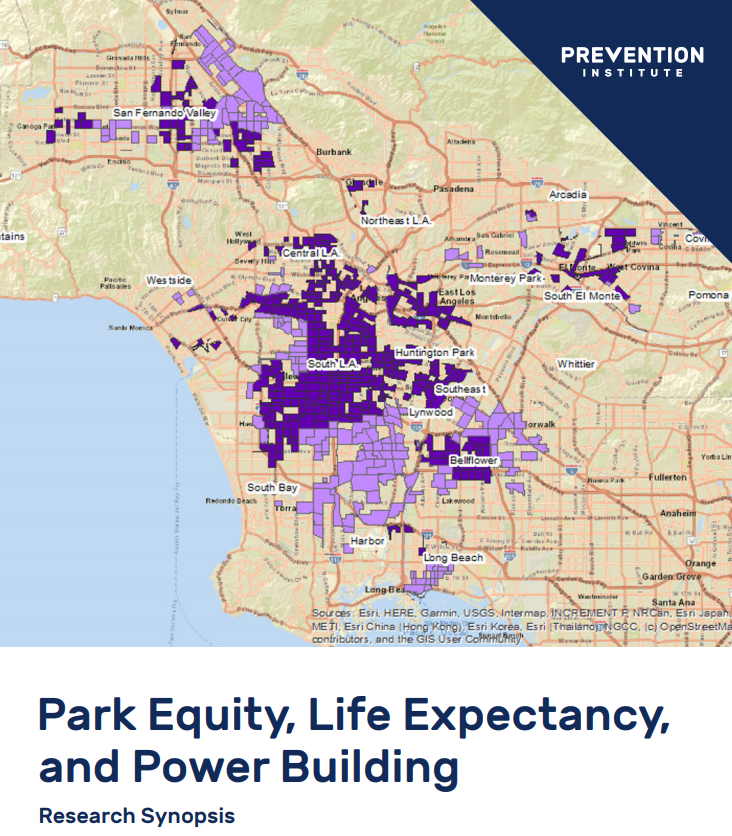Prevention Institute, in collaboration with UCLA and the Powering Healthy Lives through Parks Community Advisory Board, has published new research about the relationship between parks and life expectancy and an advocacy toolkit that community-based organizations can use to push for park equity. Based on data from the Los Angeles region, the study’s findings provide insights for communities across the country. The research shows that:
- Increasing park acreage in areas that face park deficits and low levels of tree canopy could lead to significant population-level increases in life expectancy.
- Targeted investments in park infrastructure could have considerable regional benefits and increase longevity in Latino and Black communities.
Urban parks and green spaces support health by providing opportunities for physical activity, time in nature, social connection, and respite. During the COVID-19 pandemic, they have played a crucial role in reducing stress and helping fend off depression. Parks also filter air, remove pollution, cool temperatures, and filter stormwater. But access to parks and green space is very unequal across lines of race and class. For generations, park inequities have unfairly and unjustly impacted low-income communities of color.
With resources from the Urban Institute through funds provided by the Robert Wood Johnson Foundation, Prevention Institute partnered with the UCLA Fielding School of Public Health, Department of Environmental Health Sciences and seven power-building organizations during a year-long project to understand the impacts of increasing park acreage in areas of LA County that face park deficits and low levels of tree canopy. UCLA used census tract-level data made available recently through the United States Small-Area Life Expectancy Project (USALEEP) to develop a predictive model that demonstrates the relationship between green space and life expectancy.
This project was guided by an advisory board that included seven local community-based organizations—Community Coalition, Esperanza Community Housing Corporation, Long Beach Forward, National Health Foundation, Social Justice Learning Institute, Pacoima Beautiful, and Promesa Boyle Heights—as well as the Center for Health Equity at the Los Angeles County Department of Public Health.
Click here to read the Park Equity, Life Expectancy, and Power Building Research Summary, Policy Brief, and three community profiles. Learn more about the Visualizing and Powering Healthy Lives initiative.
Check out the Advocacy Toolkit for Park Equity, Life Expectancy, and Power Building
To achieve park equity, people living in communities that have been historically excluded from park-related decision-making must be heard. The materials in PI’s Advocacy Toolkit for Park Equity, Life Expectancy, and Power Building are designed to support community-based organizations, their members, and others who are building power to secure equitable investments in park infrastructure in disinvested communities. The toolkit was developed through research in LA County and provides insights for other US cities, because the underlying factors that lead to park inequities are present throughout much of the country.
Toolkit materials include:
- A policy brief that examines the origins of park inequities, lays out a policy framework for achieving park equity, and sets forth key recommendations that can be adapted by park equity advocates throughout the US.
- A research synopsis that describes the findings from new research linking availability of parks and life expectancy at the census tract-level in Los Angeles County.
- A 4-page overview that summarizes key findings from the research synopsis and policy brief.
- Three community profiles that highlight the work of park equity advocates in Boyle Heights and unincorporated East Los Angeles; Panorama City, Pacoima, and Sun Valley; and South Los Angeles.
- Spanish translations of the 4-page overview and the community profiles.
Achieving park equity will require developing new policies and practices and reforming existing ones to: 1) prioritize investments in communities experiencing the greatest park deficits; 2) engage community members in transformative ways; 3) collect data on park inequities and make it publicly available; 4) fund comprehensive technical assistance and capacity-building; 5) support community-based organizations to be active players in parks and land-use decision-making; and 6) ensure transparency and community oversight of park investments.
For more information visit www.preventioninstitute.org

